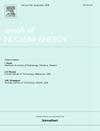不同喷射方式下熔体与冷却剂相互作用研究综述
IF 1.9
3区 工程技术
Q1 NUCLEAR SCIENCE & TECHNOLOGY
引用次数: 0
摘要
高温熔体与冷却剂的相互作用,又称为燃料-冷却剂相互作用(FCI)或冷却-冷却剂相互作用(CCI),是核反应堆事故中造成破坏的关键因素之一。根据不同的事故场景,熔体与冷却剂的相互作用模式可分为熔体喷射(MI)模式和冷却剂喷射(CI)模式。在以前的研究中,由于金属的不透明性,对CI模式进行可视化实验是具有挑战性的。考虑到CI模态与MI模态在几何上是相反的,从MI模态的研究中获得CI模态的基本相互作用机理是有希望的。因此,本文根据不同的相互作用模式,系统地总结了熔体-冷却剂相互作用的基本理论、流行实验和模拟,重点介绍了热力学和水动力相互作用过程,以及当前的热点和挑战。其核心意义在于从CI模式和MI模式的相反过程分析熔体-冷却剂相互作用,为CI模式的研究提供了新的视角。同时,本文也为后续熔冷相互作用的研究方向提供了有价值的见解,如优化现有理论模型中的经验参数,建立相应的界面传热模型和蒸汽爆炸热膨胀模型,这对预测核反应堆事故潜在风险至关重要。本文章由计算机程序翻译,如有差异,请以英文原文为准。
A review of research on melt and coolant interaction under different injection modes
The interaction of high-temperature melt with coolant, also known as fuel–coolant interaction (FCI) or coolant-coolant interaction (CCI), should be considered one of the crucial factors causing devastation in nuclear reactor accidents. Based on different accident scenarios, the interaction modes between melt and coolant can be categorized into the melt-injection (MI) mode and the coolant-injection (CI) mode. In previous research, performing visualization experiments of the CI mode was challenging due to the opacity of metals. Considering that the CI mode is geometrically opposite to the MI mode, it is promising to obtain the fundamental interaction mechanisms of the CI mode from the research on the MI mode. Therefore, this review systematically summarizes the essential theories, prevailing experiments, and simulations of melt-coolant interaction according to the different interaction modes, focusing on the thermodynamic and hydrodynamic interaction processes, as well as current hotspots and challenges. Its core significance is to analyze melt-coolant interaction from the opposite processes of the CI mode and the MI mode, which could provide a new perspective for the research of the CI mode. Meanwhile, this review offers valuable insights for the subsequent research directions of melt-coolant interaction, such as optimizing empirical parameters in existing theoretical models and developing corresponding interfacial heat transfer model and the thermal expansion model of vapor explosions, which is crucial for predicting the potential risk of nuclear reactor accidents.
求助全文
通过发布文献求助,成功后即可免费获取论文全文。
去求助
来源期刊

Annals of Nuclear Energy
工程技术-核科学技术
CiteScore
4.30
自引率
21.10%
发文量
632
审稿时长
7.3 months
期刊介绍:
Annals of Nuclear Energy provides an international medium for the communication of original research, ideas and developments in all areas of the field of nuclear energy science and technology. Its scope embraces nuclear fuel reserves, fuel cycles and cost, materials, processing, system and component technology (fission only), design and optimization, direct conversion of nuclear energy sources, environmental control, reactor physics, heat transfer and fluid dynamics, structural analysis, fuel management, future developments, nuclear fuel and safety, nuclear aerosol, neutron physics, computer technology (both software and hardware), risk assessment, radioactive waste disposal and reactor thermal hydraulics. Papers submitted to Annals need to demonstrate a clear link to nuclear power generation/nuclear engineering. Papers which deal with pure nuclear physics, pure health physics, imaging, or attenuation and shielding properties of concretes and various geological materials are not within the scope of the journal. Also, papers that deal with policy or economics are not within the scope of the journal.
 求助内容:
求助内容: 应助结果提醒方式:
应助结果提醒方式:


